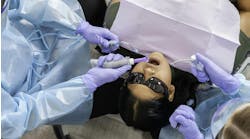Michael Kesner, DDS
How long do you want to practice dentistry? How do you plan to get "out of the mouth" one day? What is your strategy to move away from the chair yet still make the income you want and need?
I have found that most dentists have no real exit strategy. You know you don't have an exit strategy if your plan begins with "I hope," or "I was thinking," or "It would be nice if," or "Maybe I could."
These are wishes, not strategies. If you don't have a written plan, then you have no strategy. There are many exit strategy options available to you: You can sell your practice and walk away, be an associate for the buyer, hire associates, sell partnerships, build multiple practices, or do different combinations of these options.
There are two requirements for your exit strategy to work: (1) your practice must be growing, and (2) your practice must be profitable. If your practice is not growing and profitable, then the exit strategy options available to you are very limited. If your practice is successful, then there are many options available to you.
Knowing how to build a growing successful practice is imperative. Therefore, your exit strategy and your growth strategy go hand in hand. This is why you should plan your exit and growth strategies at the same time.
Many dentists don't have an exit strategy because their practice is not growing. I find this is why nearly all dentists are unable to retire at the same or better standard of living.
I once heard a dentist describe his dental practice as a "fur-lined trap." He makes a nice income and has a nice lifestyle, which will continue only as long as he is chairside. He feels trapped because when he stops doing dentistry, his income will stop. This feeling forces many dentists to stay chairside much longer than they want.
My goal was to be "out of the mouth" by the age of 55. My definition of "out of the mouth" is to do dentistry only when I want to, not because I have to financially.
I reached this goal in 2012 when I was 54 years old. By creating rapid growth and hiring associate dentists, I transitioned from seeing patients four days a week to only one or two days a month-all over a two-year period.
You can execute your exit strategy in only two to four years if you are willing to agree to three conditions.
1. Willingness to change: Change is always uncomfortable and requires a lot of effort. The way you are doing things now is producing the results you are currently experiencing. If you don't like the results you are getting, then change what you are doing.
You can't keep practicing the business of dentistry the same way and expect to get a different result. There is no "easy button"! If dentistry were easy, then everyone would be doing it.
Change is mandatory. Change is also inevitable. You will either be at the end of your career without an exit strategy and change will be forced upon you, or you will start making the necessary changes now to create the future you want.
2. Commitment to do whatever is necessary: You must be 100% committed to do whatever it takes to make your plans become reality. Commitment is an "all or nothing" deal.
When your commitment to your growth and exit plans is "all or nothing," then you will find the drive necessary to do whatever it takes. You must want your plan to succeed more than you want comfort, something easy, doing it your way, etc.
3. Getting help: Don't try to do this yourself. It will take you too long, and you will make too many costly mistakes. If you could do this by yourself, then you already would have.
The investment you make in hiring someone who has "been there and done that" will pay for itself many thousands of times over. I didn't do it by myself. I hired people who could show me the way, hold me accountable, and challenge me.
Decide today to take control of your future and implement powerful growth and exit strategies for your success.
Michael Kesner, DDS, has a practice that ranks on the Inc. 5000 list as one of the fastest growing companies in America. He is the author of the book Multi-Million Dollar Dental Practice and the CEO of Quantum Leap Success in Dentistry. They teach more production, higher profits, and less stress. Contact him at [email protected].





